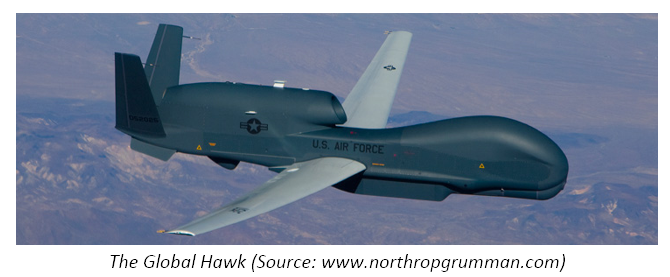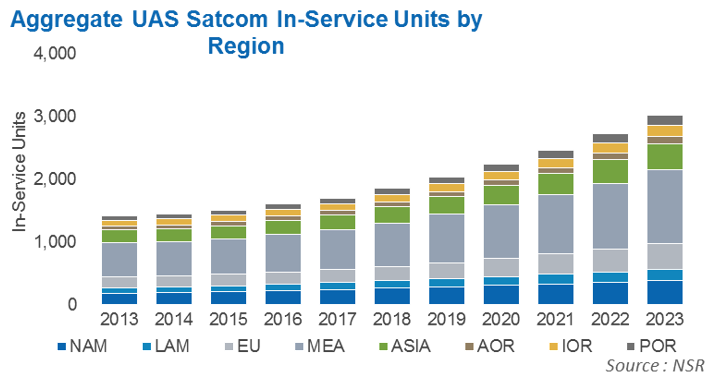The New Drone Diplomacy
Jan 29th, 2015 by
Prateep Basu, NSR
U.S. President Barack Obama’s recent visit
to India amidst much fanfare was more than symbolic of
the regional geopolitics and his ‘Asia Pivot’ policy.
Lurking somewhere behind the bonhomie between the two
Heads of State was the fate of defense deals, including
highly sought after Unmanned Aircraft Systems (UAS).
India, like other Asian powers Japan and
South Korea, has been pushing for a deal for 8 MQ-4C
Global Hawks for safeguarding its maritime sovereignty.
Unlike India, long term U.S. partners Japan and South
Korea have already received clearance for procuring the
Northrop Grumman-made UAS, which boast superior
Intelligence, Surveillance, and Reconnaissance (ISR)
capabilities.
Rewind to last decade, and the word
‘drone’ would have struck fear and spite among many due
to its extensive use in the Afghanistan and Iraq wars.
Their utility in protecting troops from dangers in war
zones, and providing ISR data have proven to be
unparalleled. But today, drones are increasingly finding
new applications such as disaster management,
humanitarian peacekeeping, and homeland security to name
a few; however, it is Defense & Intelligence (D&I) that
continues to be the major interest of States. This has
made calls louder for relaxing the outdated Missile
Technology Control Regime (MTCR), under which the trade
of these UAS falls.
The U.S. sale of High Altitude Long
Endurance (HALE) and Medium Altitude Low Endurance
(MALE) UAS such as the Global Hawk and the Reaper means
geopolitics and foreign policy will continue to
play a major role in the proliferation of UAS.
Under pressure from aerospace and defense firms, the
U.S. Government is using its diplomatic relations to
exempt friendly states from the draconian MTCR,
as Israel and China race ahead in the global trade of
UAS in this multi-billion dollar industry. And this
raises the question – are we seeing a new kind
of bilateral relationship between East and West where
drones are diplomatic tools?

The Key Words
UAS are distinguished according to their
payload capability, range and endurance. UAS have proven
their utility in both war zones, as well as for
commercial applications like monitoring of oil & gas
pipelines and assisting in wildlife conservation.
Despite a fairytale story of the rapid
evolution of UAS in the last decade and half, their
usage has been limited by two roadblocks –
availability of satellite bandwidth and airspace
regulations. With greater payload
sophistication, UAS have become more and more bandwidth
hungry devices, which has prohibited the use of a full
fleet. For example, each Global Hawk can easily
consume 50+ Mbps of bandwidth, which amounts to over
40MHz of traditional FSS capacity. To add to the
picture, most HALE and MALE UAS are designed to operate
in Ku-band, and this trend is expected to continue given
the latency in changes made to UAS designs. Airspace
regulations have been less of a concern for the main
market, which is D&I.
And We Are Talking about Them
Because…
In its recent report titled
Unmanned Aircraft Systems via Satellite,
NSR predicts the number of these larger, high
performance UAS will more than double during the
period 2013-2023, as countries stack up their
defense arsenal, but this will have to be complemented
by capacity planning over regions of growth.
Due to ongoing conflicts in the region,
the Middle-East and Africa will continue to be where
most UAS are deployed, but Asia and Europe are expected
to have considerable growth in this sector mainly due to
territorial disputes, and anti-terrorism activities.

The Bottom Line
Diplomacy using drones may be a new U.S.
tool, but shortage of capacity to support UAS operations
is not. The recent drone acquisition plans of countries
in Asia and the Middle-East provide an opportunity on
which commercial satellite operators can capitalize, and
add a bonus to President Obama’s new drone diplomacy
efforts. Availability of bandwidth and
throughput will however continue to remain the keywords
for these efforts to succeed.